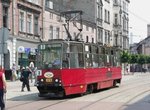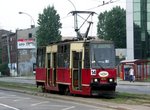Katowice, Poland
![]()
Single-truck Konstal type N tram 954 at Bytom - ul. Piekarska. Photo by Tim Deakin.
Overview
The heavily-industrialised Upper Silesian region in south eastern Poland consists of several towns and one large city, Katowice. Katowice forms a hub for the region's tramway system, which also serves the towns of Bedzin, Bytom, Chebzie, Chorzow, Gliwice, Myslowice, Sosnowiec and Zabrze amongst others. For a system operated with a medium-sized tramway fleet - about 350 cars - the network's total length is huge - between 200 and 230km of trackage, according to various sources. Whilst several sections of the network are high-frequency, high-volume urban operations, much of the track forms a true 'interurban' system. Many routes run through more rural areas, often with trees and vegetation surrounding the tram with long distances between stops. Whilst frequencies can be as low as every thirty minutes on some of these sections, ridership is - in most cases - reasonable, at least during the day. Surprisingly, several of the rural lines are served 24 hours a day.
Whilst service is generally reasonable, the same cannot be said about the condition of the tram fleet. The vast majority of cars operated are standard Polish-issue Konstal 105Na single-ended types, most of which are in a dire condition; breakdowns are common. The red paint on many is badly weatherbeaten and faded, large areas of corrosion are often apparent, doors frequently fail to work and several are decorated with considerable amounts of grafitti. Interiors would seem to have received no attention since the cars were built. Whilst some 105Nas operate as two-car sets, the majority now operate as single cars and overcrowding can be severe. There is also a small number of similar 111Na cars, which are fitted with doors on both sides and thus, when coupled back-to-back, can operate bi-directionally, although they wouldn't appear to be allocated to a particular route and are intermingled with sets of single-ended 105Na cars.
Also operated are several earlier Konstal 102Na articulated cars, which are similar in appearance to Tatra's K2 articulated tram found in a few eastern European cities. Being even older than the earliest Konstal 105Na's, the 102Na's are generally in an even worse condition; at least one had a hole in the stepwell by the rear door which it was possible to put your arm through! Operation of these cars is more sporadic, although they seem to be common on routes 11, 15 and 37.
By far the most modern cars in the fleet are seventeen Alstom Citadis low-floor articulated trams, built by Konstal which is now been an Alstom subsidiary. Taking numbers 800-816, they are designated type 116Na, and are used mainly on lines 6 and 41 between Katowice and Bytom, although they can sometimes be seen on line 16 which runs parallel along some of its length. Unfortunately there aren't enough 116Na's to cover all runs on lines 6 and 41, with only about two-thirds of service operated by low-floor cars; the remainder is covered by the high-floor Konstal 105Na's, often operated as single cars. This leads to chronic overcrowding at busy times.
Many of the Alstom cars are operated in advertising 'wraps', and none seem to carry the fleet's standard red and cream livery although one of the advertising schemes is remarkably similar. Whilst they are relatively new (dating from 2000-2001), the low-floor cars are showing signs of deferred maintenance - at least one was running for the duration of my visit with a fractured rear window, and the interiors show signs of heavy dirt.
Last, and certainly not least, is a pair of ancient bi-directional Konstal N-type cars, retained for route 38 in Bytom. Short route 38, operated by one car between Piekarska Street in Bytom and Stacja Ruchu, cannot be modified with turning loops and thus requires bi-directional cars. It is not apparent as to why the Konstal 111Na cars aren't used and the 56-year old N types retired, however - although low ridership is a possibility. These elderly twin-axle cars have hand-operated doors and are the last of their type in operation in Poland.
KZK-GOP's trams are not the only part of the system in poor condition; the same is also true of infrastructure, as a result of funding problems. Track in some places is in such visibly-poor condition that it's difficult to see how trams can pass by without derailing. As a result of these funding difficultiess, the service along two sections of tramway was withdrawn during early-2006. Line 25, in Bedzin, was replaced by buses, whilst route 8 in the Bytom area was abandoned, as it was already paralleled by existing bus routes. Considering the state of much of the track in the rural areas, light ridership on some of these sections and a pressing need to update the tram fleet, it would seem that unless the funding problem is solved, they will not be the last routes to bite the dust.
This aside, there are some wonderfully interesting features of the right-of-way. Single-track sections abound outside the towns and cities, whilst there are several sections where there is no clearance at all between the tram car and vegetation on both sides, such as the 'tunnel' section in Chebzie on lines 1 and 11. The loop in Myslowice, used by lines 14 and 26, also has zero clearance between the trees and both sides of the tram.
Despite the poor condition of both cars and track, the Silesian system is a 'must see' for any visiting railfan. As the last true interurban in Europe, it is its decrepit nature and quirky features which form much of its charm. Tickets valid for a week are available from several outlets in Katowice, and fares are exceptionally low. Apart from being one of the few places left in Poland where it's possible to ride an articulated Konstal 102Na car, there's also the opportunity to sample the vintage N-class two-axle tram used on route 38 in Bytom. Whilst the Upper Silesia region may be heavily industrialised and have little of interest tourist-wise, it is well worth a visit to see this unique system.
Photo Gallery
| Five Random Images | ||||
 Image 51919 (168k, 720x540) Photo by: Tim Deakin Location: Zawodzie - Zajezdnia |  Image 51931 (168k, 720x540) Photo by: Tim Deakin Location: Bytom - plac. Gen. Sikorsikego |  Image 51961 (121k, 720x540) Photo by: Tim Deakin Location: Zabrze - Plac. Wolnosci |  Image 51977 (105k, 720x540) Photo by: Tim Deakin Location: Zawodzie - Lacza |  Image 51980 (127k, 720x540) Photo by: Tim Deakin Location: Katowice - Rynek |
Page Credits
By Tim Deakin.